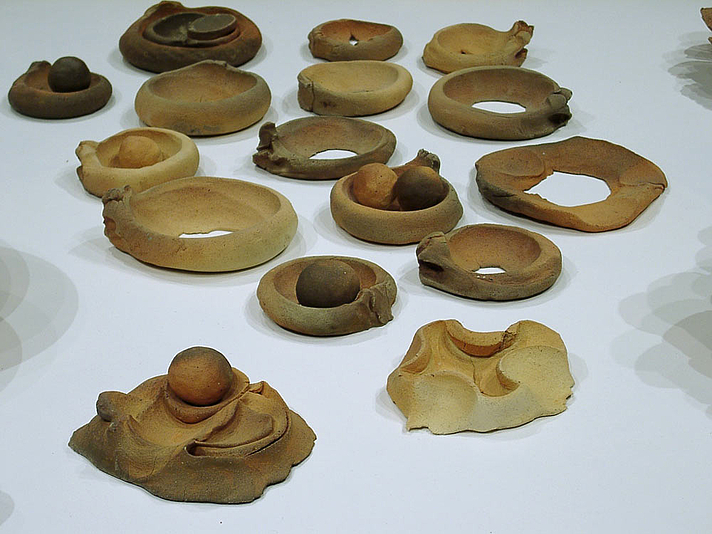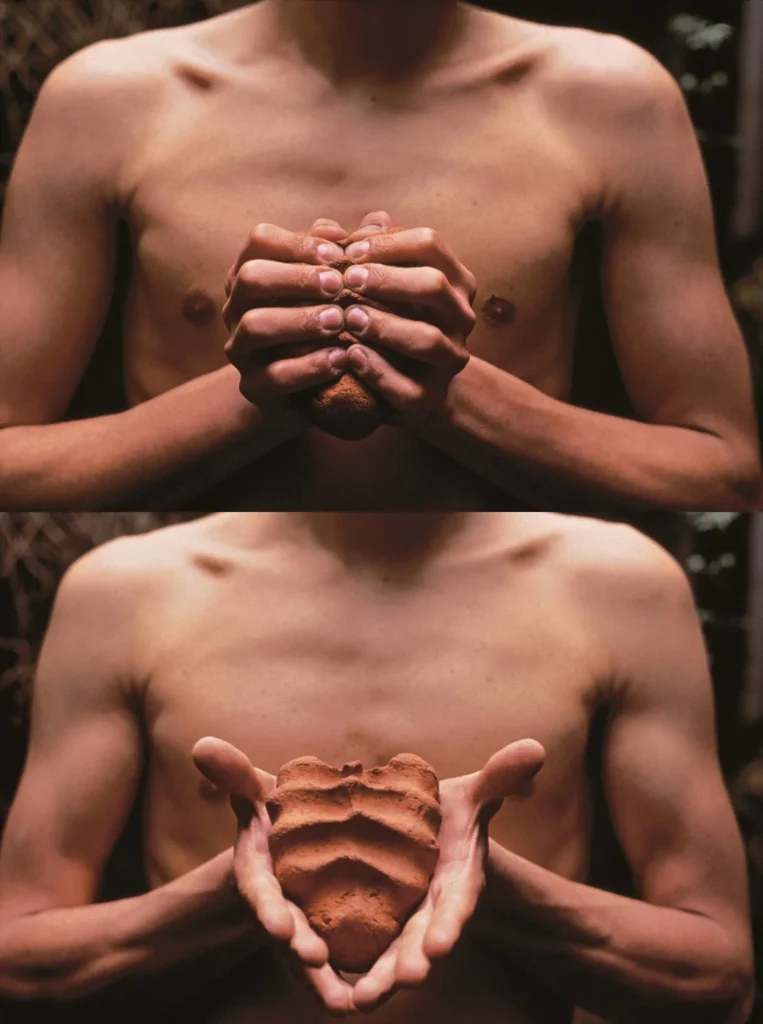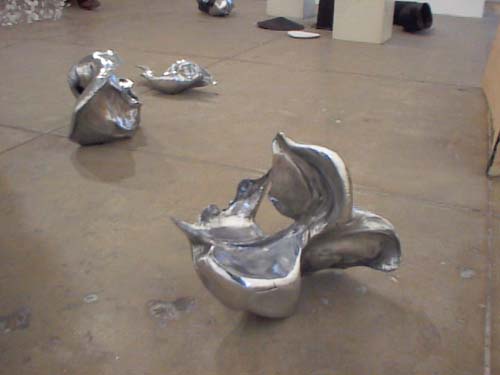Not only did I finish all the tweak editing I mentioned earlier, the momentum picked up. I worked on the pacing of some dialogue scenes, changing some breaths/gaps and taking out a few tiny lines here and there. It makes a noticeable difference (noticeable if you’ve seen the movie a hundred times; otherwise, it’s just smooth.) I was a little wary, though, since I just read an interview with Soderbergh Filmmaker Magazine. Talks about The Limey writer Lem Dobbs, who “fumes at Soderbergh for gutting his script to such an extent that Dobbs was blamed by critics for the thinness of the characters and the lack of backstory.” [It’s in the DVD commentary; buy it yourself and find out. I did.] Then I redesigned the credits, added some parentheses to the title. (It’s been Souvenir (November 2001) on a few submissions lately.) For good measure, I made a few audio level adjustments, pulling up some lines that could get a little lost.
Everything went well, smoothly. Output my new master and slave DV copies, WHICH WERE BLANK when I got them home for dubbing. Apparently, FCP didn’t recognize the camera. CHECK YOUR TAPES BEFORE YOU LEAVE. Now I’ve gotta make an emergency run Fri. morning to re-output it. It looked good, though, and it felt good to be squarely in the “making” process again, even if it’s only for a day
Author: greg
Back in March when we
Back in March when we were editing Souvenir November 2001, we spent some grim days dealing with sound. We’d recorded audio on the DV camera and on Mini-Disc (not DAT), using slate (not timecodes) to sync the sound. Then at the last minute we had problems loading the MD’s into Final Cut Pro and had to transfer them to CD. Sync’ing the audio was supposed to be easy, but it was a huge pain. Why mention this now?
In the newest issue of Filmmaker Magazine, there’s a roundtable with Steven Soderbergh’s team from Full Frontal where they talk shop. Here’s what Susan Littenberg (1st asst. ed.) says they did (note: they had two Final Cut Pro systems, which sounds luxe.):
In the last paragraph: “Is there anything that you can think of that filmmakers should avoid? Any advice you can give filmmakers before they get started on a project like Full Frontal?”
“Don’t sync audio to video in Final Cut! Take the extra time up front to do the sync dailies and reload them.”
Two takeaways: 1) We’re doin’ it more Soderbergh-style than we’d imagined (or wanted to, frankly), and 2) Finish the article before you start typing your weblog entry.
Hmm. At the end of
Hmm. At the end of this Salon interview with independent director Tom diCillo, he says, “The greatest luxury is being able to get on the set. I would do it for no money. I love doing it. I love it.” Right below it is a link to an older interview with diCillo “on the ‘tedious, boring, painful experience’ of making an independent film.”
New Project: Did I mention
New Project: Did I mention it’s animated? Actually, yeah, I did. Indirectly, anyway. Did I mention it’s a musical? Umm, yeah. Well, I’ve been researching anime, animation production, CG, and techniques today. Here are some interesting links I’ve assembled so far:
Gabriel Orozco at Documenta 11

Contrary to one writer’s opinion, Gabriel Orozco is a Mexican who can make pottery. After seeing Peter Schjeldahl’s misguided critique of Orozco’s work at Documenta 11 cited on ArtKrush to support an even broad(er)side on the state of contemporary art, I have to call bulls*** [Sorry, Mom.] on the whole thing.
Orozco’s Documenta 11 installation, Cazuelas (Beginnings), is comprised of “thrown” clay bowls. While the clay was still wet, Orozco threw smaller balls of clay into the bowls, where they were embedded like embryos in a uterine wall. The artist left deep fingermarks on the rims of some bowls, traces of where he lifted or deformed the “finished” product. Regarding this work, Schjeldahl claims Orozco’s “lively formal ideas are blunted by the artist’s rudimentary skills.”
Zooming out, this supposed failure, then, “makes the point that in today’s convulsive world everyone must learn new things. I was obliged to include myself: a New York art critic who left Kassel feeling uncomfortably marginalized.” Well, if you’re marginalized, please don’t blame it on Gabriel Orozco, whose work is, in fact, the exact opposite of “blunted,” “rudimentary,” and a “first effort.” Beginnings extends ideas and techniques Orozco has been working with for over ten years: the transformation of the humblest material by the touch, gesture, or glance of the artist.

At frenchculture.org is an image of My Hands are My Heart, a 1991 work where Orozco cradles a transformed ball of clay in his hands.

Here is an image of Made in Belgium, which was shown in Orozco’s seminal 1993 exhibit at Galerie Chantal Crousel (which also included La DS, his famously altered Citroen). Just before these roof tiles entered the kiln, Orozco grabbed and distorted them, leaving his gesture (and even his fingerprints) on the clay.

And in 1999, he showed Pinched, seductive aluminum forms cast from heavily kneaded clay. Orozco’s work at Documenta is more a culmination than a first effort, and his skills are anything but rudimentary; they’ve been honed in the public eye for at least eleven years. So if you’re looking to throw something at contemporary art, don’t take aim at Gabriel Orozco; you’ll wind up hitting yourself.
[2024 editor’s note: in 2002 I really was in the mind of the eternal, open, collective internet where everything would be forever, though I was out of my hotlinking images phase, and in a mode of not copying and hosting images I was referencing, and also posting pictures of my own with embedded captions to help people know where they came from as they circulated among the servers of the world. yeah, well, turns out the only link that still worked in this post was to my own image, so I’ve gone back and chased down updated links and just put the images on the page finally. Whether this is progress, or we’re better off than we were in the world of June 2002, I really cannot say.]
Editing: After a couple of
Editing: After a couple of false starts, we’re finally set to make the editing tweaks on Souvenir November 2001 this week. (Since I only have FCP 1.0 loaded, and the project got saved in 3.0, I couldn’t open it without 3.0.) We really worked to balance the documentary “vocabulary” of the movie, that is, the degree to which the filmmaking process asserts itself: lighting quality, high-contrast exposure rates, handheld camera movement, crew and equipment appearances. Post-preview screening, we heard strong reactions to the contrast between “performed” scenes and “documented” scenes which went to the heart of the story. The two major editing tweaks deal with this balance:
The changes should only add 15-20 seconds or so to the film. Now that it’s not constrained by the Cannes 15-minute limit, it’s fine. Also, we’ll output it to DVD and Beta SP for the first time–a definitive version, suitable for screening at your local film festival (local if you live in Park City or one of the places listed at left). Stay tuned.
How Kevin Smith may be the Most Important Filmmaker on The Internet
Kevin Smith‘s irreverent but brilliant Dogma just ended on Comedy Central (albeit in highly edited form). I sat behind Smith and his posse when it premiered at the 1999 NY Film Festival, but I haven’t seen it since. It really is great–a serious exploration of real issues of faith in an unexpected way (and by an under-the-radar believer). Smith is certainly an influence in terms of his career and his smart use of the net–via his View Askew site–to connect with his audience, if not in his actual films. Don’t get me wrong; I love his movies, but I haven’t really studied them. Here is Kevin’s online production diary from Dogma. Begun in March 1998, it’s the earliest moviemaking “weblog” I’ve found.
Unlike Schoolhouse Rock, this song has no impact on my desire to write a musical
When I posted on kottke.org about “Fifty Nifty United States,” I gave a link with the lyrics and a Real Audio file. here is that link.
Stupid Flash Tricks: South Park character generator
Apropos of nothing other than the weekend: Create a South Park version of yourself We did.

On Maya Lin’s ninja-like approach to the WTC Memorial
There’s an interesting article by Louis Menand in this week’s New Yorker about Maya Lin called “The Reluctant Memorialist.” He talks about her early rejection of any WTC Memorial-related requests and about her recent informal advisory work for the decisionmakers (as someone who’s “been through the process.”) In talking about Lin’s reticence and justifiable anger at the Viet Nam memorial process (which sounds horrific, frankly, and doesn’t give me too much hope for New York City’s efforts), it’s strange that Menand doesn’t quote from or even mention Lin’s own essay, written in 1982 but only published in 2000. [It was in the NY Review of Books and in Boundaries, a book published by Lin about her work.]
As you may know (if you’ve seen Souvenir or read the script), Lin figures into the story as an plot point and motivation; also, the Sir Edwin Lutyens memorial in the movie was cited by Lin and her teachers at Yale as a source for her VN design. That connection is also oddly absent from Menand’s article, whereas Richard Serra does get a mention, even though Lin professed to having never seen Serra’s work before designing the memorial.
On July Fourth, I watched a lot of movies and called it research. (But don’t hate me; one was Flashdance)
For the new project (comments to follow):
On hating musicals while making plans to watch Buffy; On The Umbrellas of Cherbourg, which I don’t hate
Last night was a rerun of Buffy: The Musical, Joss Whedon’s annual stunt episode of the show (two seasons ago, there was the silent episode, then the “no background noise” episode. In 2001, it was the “background singer” episode, I guess.) Not a Buffy fan, but with the gushing reviews from last fall still fresh in my conscience, we sat down to watch it. [note: Stephanie Zacharek’s Salon.com review is dripping with the vampire-inspired ecstasy that so scared the Victorians. You want to offer her a cigarette by the last paragraph. In the mean time, here’s a site with enough mp3 files and lyrics links to restage the whole thing at home.]
Anyway, it was pretty interesting, especially for the unexpectedness of it. Favorite lines were self-referential: “Off we go to stop the killer/ I think this line is mostly filler.” And it was pretty game of the whole cast to sing. Makes me wonder, what if Catherine Deneuve hadn’t been dubbed in Jacques Demy’s Umbrellas of Cherbourg? Cherbourg is a bizarre (if you think about it) technicolor classic where garagistes offhandedly sing about fixing the fuel injector on a Mercedes. Thanks go to Agnes Varda, whose tireless efforts to restore and rerelease Cherbourg in 1992 brought the film–and her former husband’s reputation–new life.
[Chicago Reader has a looong, impassioned article from 1996 about Demy and coming to love Cherbourg. Buy Cherbourg here.]
Even though I hate musicals (with the exceptions noted previously), or maybe because I hate musicals, I feel compelled to make one. If only to rationalize writing about Buffy, The new project I’m working on (in addition to the feature-length story incorporating Souvenir) is a musical. I guess I’d better add streaming to the site.
How Wes Anderson influences my career (minor)
To paraphrase Max Fischer: I’ve applied for early admission to the Edinburgh Film Festival and Cannes. Sundance is my safety.
[wesanderson.org is a good source for active fans.]
How the Village Voice agrees with me (generally) on Documenta 11
It may be a little overwrought (“So let’s receive this Documenta as the proclamation of a state of emergency.”), but Kim Levin’s Village Voice review of Documenta 11 is pretty right on. I mean, she generally agrees with me, reinforcing my own innate sense of astuteness and acuity. Be afraid. Be very afraid.
How my film is(not) like a busload of Chinese tourists looking at a famous war memorial
This morning, I did a driveby at the Iwo Jima Memorial (there had been a big formation of Marines there earlier in the day). Whatever Americans know of Iwo Jima today, it’s almost certain they recognize the statue. It was based on a photograph by Life Magazine combat cameraman, Joe Rosenthal [Iwojima.com has good background information.] Within 72 hours, the first 3-dimensional version, sculpted in clay by Felix deWeldon. The monument followed on a wave of popular sentiment.
As I drove by, a busload of Chinese tourists was busy snapping pictures of each other with the monument in the background. Only, they were all at the “head” of the monument, on the “wrong” axis of the sculpture/photograph. At first, I smirked at their cluelessness, but then its source became obvious, and the monument’s utter dependence on the photo alarmed me.
I would bet they had no knowledge of the monument’s (formal) origins. A monument that is inextricably linked to an image will eventually have to serve people who have no shared cultural experience, who haven’t been “trained” through repeated viewing of an image (and through history taught with this image). It ends up serving as a monument to the WWII-era American public’s media-driven remembrance; we are still living in the shadow of that memory.
Iwo Jima is at least one or two generations closer, historical distance-wise, than the WWI memorials in Souvenir November 2001, but the separation of the memorial and the cultural memory is already showing.
